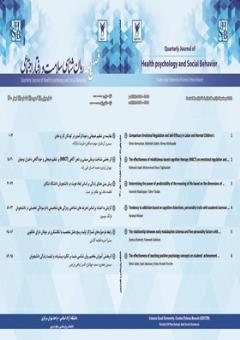پیشبینی شادکامی بر اساس سبک دلبستگی و بهزیستی روانشناختی در دانشجویان
محورهای موضوعی : روان شناسی
شیماء اسدیان
1
![]() ,
نرگس برزآبادی فراهانی
2
,
نرگس برزآبادی فراهانی
2
![]()
1 - روانشناسی.علوم انسانی.دانشگاه آزاد اسلامی واحد تهران جنوب.تهران. ایران
2 - عضو هیأت علمی گروه مشاوره،واحد تهران جنوب، دانشگاه آزد اسلامی .تهران. ایران
کلید واژه: دلبستگی, بهزیستی, روان, شادکامی, دانشجویان,
چکیده مقاله :
هدف: این پژوهش با هدف بررسی رابطه دلبستگی و بهزیستی روانشناختی با شادکامی و تعیین نقش سبک دلبستگی و بهزیستی روانشناختی در پیشبینی شادکامی دانشجویان بود. روش: جامعه آماری این پژوهش کلیه دانشجویان دانشگاه آزاد اسلامی واحد الکترونیک در سال 1400-1401 به تعداد 2000 نفر بود. حجم نمونه با استفاده از فرمول فیدل و تاباچینگ به تعداد 154 نفر، به روش نمونهگیری در دسترس انتخاب گردید. ابزار پژوهش پرسشنامه بهزیستی روانشناختی ریف(2004)، پرسشنامه سبک دلبستگی هازان و شیور (1987) و آزمون شادکامی آکسفورد (1990) بود. دادهها با استفاده از روشهای آمار توصیفی و بهرهگیری از آزمونهای همبستگی پیرسون و آزمون رگرسیون خطی با کمک نرم افزار spss نسخه 23 مورد تجزیه و تحلیل قرار گرفت. یافتهها: بین بهزیستی روانشناختی (62/0 = r و 001/0 = p) و سبک دلبستگی ایمن (63/0 = r و 001/0= p) با شادکامی رابطه مثبت و معنادار و بین سبک اجتنابی (44/0- =r و 017/0= p) و سبک دوسوگرا (49/0- = r و 012/0 = p) با شادکامی رابطه منفی و غیرمستقیمی وجود دارد. نتیجهگیری: نتایج آزمون رگرسیون حاکی از این بود که دلبستگی و بهزیستی روانشناختی، شادکامی در دانشجویان را پیشبینی میکند.
Aim: This research aimed to investigate the relationship between attachment and psychological well-being with happiness and to determine the role of attachment style and psychological well-being in predicting students' happiness. Method: The statistical population of this research was all students of the Islamic Azad University of Electronics Department in the year 2001-2001, numbering 2000 people. The sample size was selected using Fidel and Tabaching's formula of 154 people, using available sampling method. Research tools were Riff psychological well-being questionnaire (2004), Hazan and Shaver attachment style questionnaire (1987) and Oxford happiness test (1990). The data was analyzed using descriptive statistics methods and Pearson correlation tests and linear regression tests with the help of spss software version 23. Results: There is a positive and significant relationship between psychological well-being (r = 0.62 and p = 0.001) and secure attachment style (r = 0.63 and p = 0.001) with happiness and between avoidant style (-0.44). r = 0.017 and p = 0.017) and ambivalent style (r = 0.49 and p = 0.012) has a negative and indirect relationship with happiness. Conclusion: The results of the regression test indicated that attachment and psychological well-being predict happiness in students.


